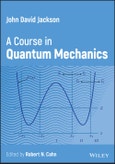Unique graduate-level textbook on quantum mechanics by John David Jackson, author of the renowned Classical Electrodynamics
A Course in Quantum Mechanics is drawn directly from J. D. Jackson’s detailed lecture notes and problem sets. It is edited by his colleague and former student Robert N. Cahn, who has taken care to preserve Jackson’s unique style. The textbook is notable for its original problems focused on real applications, with many addressing published data in accompanying tables and figures. Solutions are provided for problems that are critical for understanding the material and that lead to the most important physical consequences.
Overall, the text is comprehensive and comprehensible; derivations and calculations come with clearly explained steps. More than 120 figures illustrate underlying principles, experimental apparatus, and data.
In A Course in Quantum Mechanics readers will find detailed treatments of:
- Wave mechanics of de Broglie and Schrödinger, the Klein-Gordon equation and its non-relativistic approximation, free particle probability current, expectation values.
- Schrödinger equation in momentum space, spread in time of a free-particle wave packet, density matrix, Sturm-Liouville eigenvalue problem.
- WKB formula for bound states, example of WKB with a power law potential, normalization of WKB bound state wave functions, barrier penetration with WKB.
- Rotations and angular momentum, representations, Wigner d-functions, addition of angular momenta, the Wigner-Eckart theorem.
- Time-independent perturbation theory, Stark, Zeeman, Paschen-Back effects, time-dependent perturbation theory, Fermi’s Golden Rule.
- Atomic structure, helium, multiplet structure, Russell-Saunders coupling, spin-orbit interaction, Thomas-Fermi model, Hartree-Fock approximation.
- Scattering amplitude, Born approximation, allowing internal structure, inelastic scattering, optical theorem, validity criterion for the Born approximation, partial wave analysis, eikonal approximation, resonance.
- Semi-classical and quantum electromagnetism, Aharonov-Bohm effect, Lagrangian and Hamiltonian formulations, gauge invariance, quantization of the electromagnetic field, coherent states.
- Emission and absorption of radiation, dipole transitions, selection rules, Weisskopf-Wigner treatment of line breadth and level shift, Lamb shift.
- Relativistic quantum mechanics, Klein-Gordon equation, Dirac equation, two-component reduction, hole theory, Foldy-Wouthuysen transformation, Lorentz covariance, discrete symmetries, non-relativistic and relativistic Compton scattering.
Table of Contents
1 Basics
1.1 Wave Mechanics of De Broglie and Schrödinger
1.2 Klein-Gordon Equation
1.3 Non-Relativistic Approximation
1.4 Free Particle Probability Current
1.5 Expectation Values
1.6 Particle in a Static, Conservative Force Field
1.7 Ehrenfest’s Theorem
1.8 Schrödinger Equation in Momentum Space
1.9 Spread in Time of a Free-Particle Wave Packet
1.10 Interpretation and Application
1.11 Sturm-Liouville Eigenvalue Problem
1.12 Linear Operators on Functions
1.13 Eigenvalue Problem for a Hermitian Operator
1.14 Time-Independent Schrödinger Equation
2 General Principles of Quantum Mechanics
3 Problems in One Dimension
4 Wentzel-Kramers-Brillouin (WKB) Approximation
4.1 Solution in One Dimension
4.2 Schrödinger Equation for the Linear Potential
4.3 Connection Formulae for WKB
4.4 WKB Formula for Bound States
4.5 Example of WKB with a Power Law Potential
4.6 Normalization of WKB Bound State Wave Functions
4.7 Barrier Penetration With WKB
5 Problems in Three Dimensions
6 Rotations and Angular Momentum
7 Perturbation Methods and Applications
8 Time-Dependent Perturbation Theory
9 Atomic Structure
10 Scattering
10.1 Scattering Amplitude
10.2 Born Approximation
10.3 Allowing Internal Structure
10.4 Inelastic Scattering
10.5 Optical Theorem
10.6 Validity Criterion for the First Born Approximation
10.7 Method of Partial Waves
10.8 Behavior of the Cross Section and the Argand Diagram
10.9 Hard Sphere Scattering
10.10 Strongly Attractive Potentials and Resonance
11 Semi-Classical and Quantum Electromagnetic Field
11.1 Aharanov-Bohm Effect
11.2 Semi-Classical Radiation Theory
11.3 Scalar Field Quantization
11.4 Quantization of the Radiation Field
11.5 States of the Electromagnetic Field
11.6 Vacuum Expectation Values of E, E Times E Over Finite Volume
11.7 Classical vs Quantum Radiation
11.8 Quasi-Classical Fields and Coherent States
12 Emission and Absorption of Radiation
12.1 Matrix Elements and Rates
12.2 Dipole Transitions
12.3 Charged Particle in Central Field
12.4 Including Spin
12.5 Line Breadth and Level Shift
13 Relativistic Electron Theory
A Mathematical Tools
A.1 Integration by Parts with the Divergence Theorem
A.2 Contour Integration
A.3 Green Function for Helmholtz Equation
B Problems
C Selected Solutions








